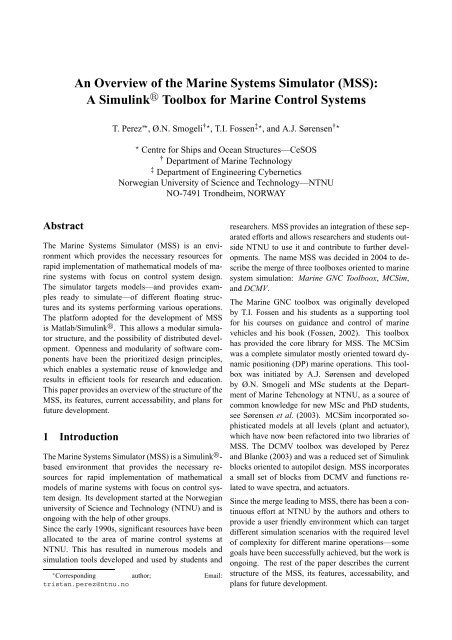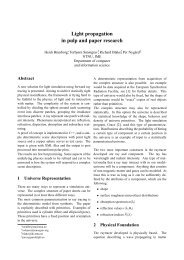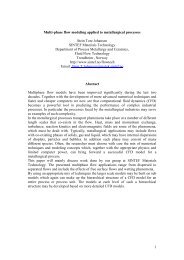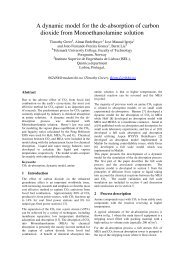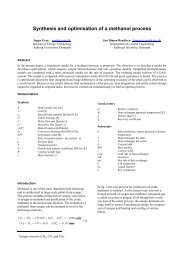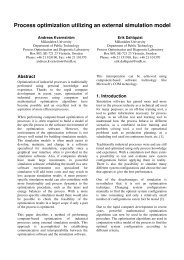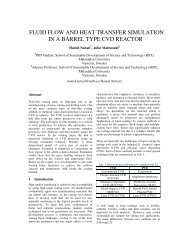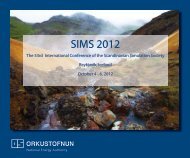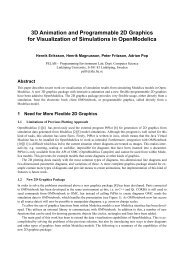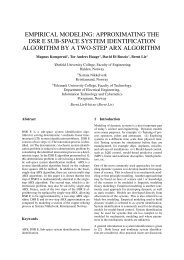An Overview of the Marine Systems Simulator (MSS): A Simulink ...
An Overview of the Marine Systems Simulator (MSS): A Simulink ...
An Overview of the Marine Systems Simulator (MSS): A Simulink ...
Create successful ePaper yourself
Turn your PDF publications into a flip-book with our unique Google optimized e-Paper software.
<strong>An</strong> <strong>Overview</strong> <strong>of</strong> <strong>the</strong> <strong>Marine</strong> <strong>Systems</strong> <strong>Simulator</strong> (<strong>MSS</strong>):<br />
A <strong>Simulink</strong> R Toolbox for <strong>Marine</strong> Control <strong>Systems</strong><br />
T. Perez ∗⋆ , Ø.N. Smogeli †⋆ , T.I. Fossen ‡⋆ , and A.J. Sørensen †⋆<br />
⋆ Centre for Ships and Ocean Structures—CeSOS<br />
† Department <strong>of</strong> <strong>Marine</strong> Technology<br />
‡ Department <strong>of</strong> Engineering Cybernetics<br />
Norwegian University <strong>of</strong> Science and Technology—NTNU<br />
NO-7491 Trondheim, NORWAY<br />
Abstract<br />
The <strong>Marine</strong> <strong>Systems</strong> <strong>Simulator</strong> (<strong>MSS</strong>) is an environment<br />
which provides <strong>the</strong> necessary resources for<br />
rapid implementation <strong>of</strong> ma<strong>the</strong>matical models <strong>of</strong> marine<br />
systems with focus on control system design.<br />
The simulator targets models—and provides examples<br />
ready to simulate—<strong>of</strong> different floating structures<br />
and its systems performing various operations.<br />
The platform adopted for <strong>the</strong> development <strong>of</strong> <strong>MSS</strong><br />
is Matlab/<strong>Simulink</strong> R . This allows a modular simulator<br />
structure, and <strong>the</strong> possibility <strong>of</strong> distributed development.<br />
Openness and modularity <strong>of</strong> s<strong>of</strong>tware components<br />
have been <strong>the</strong> prioritized design principles,<br />
which enables a systematic reuse <strong>of</strong> knowledge and<br />
results in efficient tools for research and education.<br />
This paper provides an overview <strong>of</strong> <strong>the</strong> structure <strong>of</strong> <strong>the</strong><br />
<strong>MSS</strong>, its features, current accessability, and plans for<br />
future development.<br />
1 Introduction<br />
The <strong>Marine</strong> <strong>Systems</strong> <strong>Simulator</strong> (<strong>MSS</strong>) is a <strong>Simulink</strong> R -<br />
based environment that provides <strong>the</strong> necessary resources<br />
for rapid implementation <strong>of</strong> ma<strong>the</strong>matical<br />
models <strong>of</strong> marine systems with focus on control system<br />
design. Its development started at <strong>the</strong> Norwegian<br />
university <strong>of</strong> Science and Technology (NTNU) and is<br />
ongoing with <strong>the</strong> help <strong>of</strong> o<strong>the</strong>r groups.<br />
Since <strong>the</strong> early 1990s, significant resources have been<br />
allocated to <strong>the</strong> area <strong>of</strong> marine control systems at<br />
NTNU. This has resulted in numerous models and<br />
simulation tools developed and used by students and<br />
∗ Corresponding author; Email:<br />
tristan.perez@ntnu.no<br />
researchers. <strong>MSS</strong> provides an integration <strong>of</strong> <strong>the</strong>se separated<br />
efforts and allows researchers and students outside<br />
NTNU to use it and contribute to fur<strong>the</strong>r developments.<br />
The name <strong>MSS</strong> was decided in 2004 to describe<br />
<strong>the</strong> merge <strong>of</strong> three toolboxes oriented to marine<br />
system simulation: <strong>Marine</strong> GNC Toolboox, MCSim,<br />
and DCMV.<br />
The <strong>Marine</strong> GNC toolbox was originally developed<br />
by T.I. Fossen and his students as a supporting tool<br />
for his courses on guidance and control <strong>of</strong> marine<br />
vehicles and his book (Fossen, 2002). This toolbox<br />
has provided <strong>the</strong> core library for <strong>MSS</strong>. The MCSim<br />
was a complete simulator mostly oriented toward dynamic<br />
positioning (DP) marine operations. This toolbox<br />
was initiated by A.J. Sørensen and developed<br />
by Ø.N. Smogeli and MSc students at <strong>the</strong> Department<br />
<strong>of</strong> <strong>Marine</strong> Tehcnology at NTNU, as a source <strong>of</strong><br />
common knowledge for new MSc and PhD students,<br />
see Sørensen et al. (2003). MCSim incorporated sophisticated<br />
models at all levels (plant and actuator),<br />
which have now been refactored into two libraries <strong>of</strong><br />
<strong>MSS</strong>. The DCMV toolbox was developed by Perez<br />
and Blanke (2003) and was a reduced set <strong>of</strong> <strong>Simulink</strong><br />
blocks oriented to autopilot design. <strong>MSS</strong> incorporates<br />
a small set <strong>of</strong> blocks from DCMV and functions related<br />
to wave spectra, and actuators.<br />
Since <strong>the</strong> merge leading to <strong>MSS</strong>, <strong>the</strong>re has been a continuous<br />
effort at NTNU by <strong>the</strong> authors and o<strong>the</strong>rs to<br />
provide a user friendly environment which can target<br />
different simulation scenarios with <strong>the</strong> required level<br />
<strong>of</strong> complexity for different marine operations—some<br />
goals have been successfully achieved, but <strong>the</strong> work is<br />
ongoing. The rest <strong>of</strong> <strong>the</strong> paper describes <strong>the</strong> current<br />
structure <strong>of</strong> <strong>the</strong> <strong>MSS</strong>, its features, accessability, and<br />
plans for future development.
User<br />
Education<br />
Research Industry<br />
Model complexity<br />
Research Academic<br />
Simulation<br />
Scenario<br />
Process plant models<br />
Control plant models<br />
Low level (actuator) models<br />
Implementation<br />
Felxibility<br />
Elementary components<br />
Full systems<br />
Figure 1: Simulation scenario space<br />
2 <strong>MSS</strong> scope<br />
The scope <strong>of</strong> a simulator is defined in terms <strong>of</strong> <strong>the</strong> different<br />
simulation scenarios it can handle. These different<br />
scenarios can be fur<strong>the</strong>r specified according to <strong>the</strong><br />
following elements:<br />
• Model complexity,<br />
• Implementation flexibility,<br />
• User pr<strong>of</strong>iciency.<br />
Figure 1 illustrates this concept by making an analogy<br />
to our familiar three-dimensional space.<br />
The model complexity is determined by <strong>the</strong> purpose <strong>of</strong><br />
<strong>the</strong> model and its simulation. In ma<strong>the</strong>matical modeling,<br />
<strong>the</strong>re is a fundamental trade-<strong>of</strong>f between models<br />
<strong>of</strong> great complexity, which yield a highly accurate description<br />
<strong>of</strong> many aspects <strong>of</strong> real systems and simplified<br />
models, which capture <strong>the</strong> fundamental aspects <strong>of</strong><br />
<strong>the</strong> system and are ma<strong>the</strong>matical tractable for analysis<br />
(Naylor and Sell, 1982). Within <strong>the</strong> control literature<br />
complex models (process plant models) are used<br />
to test control strategies and benchmark <strong>the</strong> more simple<br />
models (control plant models) used for <strong>the</strong> design<br />
<strong>of</strong> control strategies and analysis (e.g., robustness, stability,<br />
fundamental limitations) (Goodwin et al., 2001;<br />
Sørensen, 2005b; Sørensen, 2005a; Perez, 2005).<br />
A simulator for marine systems (ships, <strong>of</strong>fshore structured,<br />
underwater vehicles, fisheries, etc.) needs to<br />
account fur<strong>the</strong>r for <strong>the</strong> variability <strong>of</strong> <strong>the</strong> models according<br />
to <strong>the</strong> particular operation performed by <strong>the</strong><br />
vessel, state <strong>of</strong> <strong>the</strong> sea, and speed. Changes in <strong>the</strong>se<br />
system attributes result in changes in <strong>the</strong> response <strong>of</strong><br />
<strong>the</strong> marine system, response <strong>of</strong> actuators, and control<br />
objectives, which in turn may lead to <strong>the</strong> need <strong>of</strong> different<br />
types <strong>of</strong> models. For example, consider <strong>the</strong> case<br />
<strong>of</strong> dynamic positioning (DP) <strong>of</strong> an <strong>of</strong>fshore vessel. In<br />
calm to medium seas, <strong>the</strong> main control objective <strong>of</strong> <strong>the</strong><br />
DP system could be to regulate <strong>the</strong> position (North,<br />
East and heading) by rejecting slowly varying disturbances<br />
due to mean wave forces, current and wind.<br />
As <strong>the</strong> severity <strong>of</strong> <strong>the</strong> sea state increases, <strong>the</strong> oscillatory<br />
motion induced by <strong>the</strong> waves <strong>of</strong>ten needs to be<br />
included as a disturbance and <strong>the</strong> reduction <strong>of</strong> pitchand<br />
roll-induced wave oscillatory motion can be incorporated<br />
as additional control objectives. This demands<br />
changes in <strong>the</strong> models (number <strong>of</strong> DOF, and<br />
disturbance models) used by <strong>the</strong> observers and control<br />
system.<br />
The implementation flexibility <strong>of</strong> a simulator describes<br />
whe<strong>the</strong>r existing models and simulation scenarios can<br />
be easily adapted to implement new types <strong>of</strong> systems<br />
using <strong>the</strong> allocated resources. This is a particularly<br />
challenging aspect <strong>of</strong> marine system simulators due<br />
to <strong>the</strong> diversity <strong>of</strong> ships and <strong>of</strong>fshore structures and<br />
<strong>the</strong> operations <strong>the</strong>y perform. Therefore, openness and<br />
modularity <strong>of</strong> s<strong>of</strong>tware components have to be prioritized<br />
as design principles for systematic reuse <strong>of</strong><br />
knowledge. In <strong>the</strong> case <strong>of</strong> <strong>MSS</strong>, <strong>Simulink</strong> R has been<br />
adopted as a development platform because <strong>of</strong> <strong>the</strong> following<br />
reasons:<br />
• <strong>Simulink</strong> R <strong>of</strong>fers <strong>the</strong> necessary modularity and<br />
ease <strong>of</strong> implementation required for a flexible<br />
simulator.<br />
• Matlab R and <strong>Simulink</strong> R have become a tool<br />
widely used in education and research; this adds<br />
to <strong>the</strong> flexibility <strong>of</strong> <strong>MSS</strong>, because many students<br />
and scientists have access to this development<br />
platform.<br />
• Matlab R has <strong>the</strong> great advantage that <strong>the</strong> many<br />
low-level issues have been addressed: numerical<br />
integration routines, plotting tools, data exchange<br />
and exporting facilities.<br />
• The real-time workshop facilities <strong>of</strong><br />
Matlab R /<strong>Simulink</strong> R provides a way <strong>of</strong> rapidly<br />
generating prototype controllers based on<br />
<strong>Simulink</strong> diagrams that run in real time on<br />
stand-alone computer systems for tests on scale<br />
models or full scale systems. This also <strong>of</strong>fers<br />
<strong>the</strong> possibility <strong>of</strong> implementing hardware-in-<strong>the</strong>loop<br />
simulations. This is particularly important<br />
for us, at NTNU, because students can easily<br />
implement <strong>the</strong>ir controllers in <strong>the</strong> scale models<br />
at <strong>the</strong> <strong>Marine</strong> Cybernetics Laboratory—see<br />
http://www.itk.ntnu.no/marinkyb/MCLab/
o n<br />
x n North<br />
y n East<br />
z n Down<br />
o h<br />
z h<br />
x h<br />
y h<br />
o b<br />
r<br />
Heave<br />
z b ,w<br />
p<br />
Surge<br />
x b ,u<br />
q<br />
Sway<br />
y b ,v<br />
Figure 2: Notation and sign conventions for ship motion<br />
description.<br />
With regards to users, <strong>MSS</strong> <strong>of</strong>fers different options.<br />
<strong>MSS</strong> originally evolved as a way <strong>of</strong> increasing accessibility<br />
and reuse <strong>of</strong> knowledge for students and<br />
researchers at NTNU. Different components <strong>of</strong> what<br />
now is <strong>MSS</strong> have been used in education and research<br />
for several years and it incorporates several demos <strong>of</strong><br />
complete systems in particular operations. However,<br />
due to its modularity and organisation, <strong>MSS</strong> <strong>of</strong>fers a<br />
core library <strong>of</strong> elementary blocks and functions which<br />
can be combined to generate new systems to cover research<br />
needs in both industry and academia.<br />
3 Ma<strong>the</strong>matical models in <strong>MSS</strong><br />
To understand <strong>the</strong> s<strong>of</strong>tware organization <strong>of</strong> <strong>MSS</strong>, let us<br />
briefly review <strong>the</strong> main components <strong>of</strong> models a marine<br />
system. At <strong>the</strong> same time, we will introduce <strong>the</strong><br />
main conventions adopted in <strong>MSS</strong>.<br />
3.1 Reference frames and magnitudes<br />
To describe <strong>the</strong> general motion <strong>of</strong> a marine system,<br />
we need to consider three coordinates to define translations<br />
and three coordinates to define <strong>the</strong> orientation<br />
(6DOF). These coordinates are defined using two<br />
types <strong>of</strong> reference frames: inertial frames and bodyfixed<br />
frames. Figure 2 shows <strong>the</strong> different reference<br />
frames adopted in <strong>MSS</strong>, which are fur<strong>the</strong>r specified<br />
below (Fossen, 2002; Sørensen, 2005b; Sørensen,<br />
2005a; Perez, 2005):<br />
• North-east-down frame (n-frame). The n-<br />
frame (o n ,x n ,y n ,z n ) is fixed to <strong>the</strong> Earth. The<br />
positive x n -axis points towards <strong>the</strong> North, <strong>the</strong> positive<br />
y n -axis towards <strong>the</strong> East, and <strong>the</strong> positive z n -<br />
axis towards <strong>the</strong> centre <strong>of</strong> <strong>the</strong> Earth. The origin,<br />
o n , is located on mean water free-surface at an appropriate<br />
location. This frame is considered inertial.<br />
• Body-fixed frame (b-frame; forwardstarboard-down).<br />
The b-frame (o b ,x b ,y b ,z b )<br />
is fixed to <strong>the</strong> hull. The positive x b -axis points<br />
towards <strong>the</strong> bow, <strong>the</strong> positive y b -axis points<br />
towards starboard and <strong>the</strong> positive z b -axis points<br />
downwards. For marine vehicles, <strong>the</strong> axes <strong>of</strong> this<br />
frame are chosen to coincide with <strong>the</strong> principal<br />
axes <strong>of</strong> inertia; this determines <strong>the</strong> position <strong>of</strong> <strong>the</strong><br />
origin <strong>of</strong> <strong>the</strong> frame, o b .<br />
• Hydrodynamic frame (h-frame; forwardstarboard-down).<br />
The h-frame (o h ,x h ,y h ,z h ) is<br />
not fixed to <strong>the</strong> hull; it moves at <strong>the</strong> average<br />
speed <strong>of</strong> <strong>the</strong> vessel following its path. The x h -<br />
y h plane coincides with <strong>the</strong> mean-water free surface.<br />
The positive x h -axis points forward and it<br />
is aligned with <strong>the</strong> low-frequency heading angle<br />
ψ 1 . The positive y h -axis points towards starboard,<br />
and <strong>the</strong> positive z h -axis points downwards.<br />
The origin o h is determined such that <strong>the</strong> z h -axis<br />
passes through <strong>the</strong> time-average position <strong>of</strong> <strong>the</strong><br />
centre <strong>of</strong> gravity. This frame is usually considered<br />
when <strong>the</strong> vessel travels at a constant average<br />
speed (which also includes <strong>the</strong> case <strong>of</strong> zero<br />
speed); and <strong>the</strong>refore, <strong>the</strong> wave-induced motion<br />
makes <strong>the</strong> vessel oscillate with respect to <strong>the</strong> h-<br />
frame. This frame is considered inertial.<br />
Each <strong>of</strong> <strong>the</strong>se frames has a specific use. For example,<br />
<strong>the</strong> n-frame is used to define <strong>the</strong> position and orientation<br />
<strong>of</strong> <strong>the</strong> vessel as well as <strong>the</strong> current and wind<br />
direction. The linear and angular velocity and acceleration<br />
measurements taken on board are referred to <strong>the</strong><br />
b-frame, which is also used to formulate <strong>the</strong> equations<br />
<strong>of</strong> motion. The h-frame is used in hydrodynamics to<br />
compute <strong>the</strong> forces and motion due to <strong>the</strong> interaction<br />
between <strong>the</strong> hull and <strong>the</strong> waves in particular scenarios.<br />
These data are generally used for preliminary ship design<br />
(Couser, 2000); and <strong>the</strong>refore, it can also be used<br />
to obtain models. The h-frame is also used to define<br />
local wave elevation and to calculate indices related to<br />
performance <strong>of</strong> <strong>the</strong> crew or comfort <strong>of</strong> passengers—<br />
see Perez (2005).<br />
1 The angle ¯ψ is obtained by filtering out <strong>the</strong> 1st-order waveinduced<br />
motion (oscillatory motion), and keeping <strong>the</strong> low frequency<br />
motion, which can be ei<strong>the</strong>r equilibrium or slowly-varying.<br />
Hence, ¯ψ is constant for a ship sailing in a straight-line path.
The north-east-down position <strong>of</strong> a ship is defined by<br />
<strong>the</strong> coordinates <strong>of</strong> <strong>the</strong> origin <strong>of</strong> <strong>the</strong> b-frame, o b , relative<br />
to <strong>the</strong> n-frame:<br />
r n o b<br />
[ n, e, d ] T<br />
.<br />
The attitude <strong>of</strong> a ship is defined by <strong>the</strong> orientation <strong>of</strong><br />
<strong>the</strong> b-frame relative to <strong>the</strong> n-frame. This is given by<br />
<strong>the</strong> vector <strong>of</strong> Euler angles,<br />
Θ nb [ φ, θ, ψ ] T<br />
, (1)<br />
which take <strong>the</strong> n-frame into <strong>the</strong> orientation <strong>of</strong> <strong>the</strong> b-<br />
frame. Following <strong>the</strong> notation <strong>of</strong> Fossen (1994; 2002),<br />
<strong>the</strong> generalised position vector (or position-orientation<br />
vector) is defined as:<br />
[ ] r<br />
n<br />
η ob<br />
= [n,e,d,φ,θ,ψ] T . (2)<br />
Θ nb<br />
The linear and angular velocities <strong>of</strong> <strong>the</strong> ship are more<br />
conveniently expressed in <strong>the</strong> b-frame. The generalised<br />
velocity vector (or linear-angular velocity vector)<br />
given in <strong>the</strong> b-frame is defined as:<br />
[ ] v<br />
b<br />
ν ob<br />
ω b = [u,v,w, p,q,r] T , (3)<br />
nb<br />
where<br />
• v b o b<br />
= [u,v,w] T is <strong>the</strong> linear velocity <strong>of</strong> <strong>the</strong> point<br />
o b expressed in <strong>the</strong> b-frame—see Figure 2.<br />
• ω b nb = [p,q,r]T is <strong>the</strong> angular velocity <strong>of</strong> <strong>the</strong> b-<br />
frame with respect to <strong>the</strong> n-frame expressed in <strong>the</strong><br />
b-frame.<br />
Table 1 summarizes <strong>the</strong> adopted notation.<br />
3.2 Equations <strong>of</strong> motion<br />
Using <strong>the</strong> notation <strong>of</strong> <strong>the</strong> previous section, <strong>the</strong> general<br />
form <strong>of</strong> <strong>the</strong> equations <strong>of</strong> motion <strong>of</strong> a marine system<br />
can be written in a vector form as<br />
M˙ν+C(ν,ν r )+D(ν r ,µ)+g(η) = τ env + τ ctrl , (4)<br />
˙µ= A m µ+ B m ν r , (5)<br />
˙η = J n b (Θ nb)ν, (6)<br />
where M = MRB b + Mb A<br />
is <strong>the</strong> total mass matrix (rigid<br />
body + constant added mass) with all <strong>the</strong> moments and<br />
products <strong>of</strong> inertia taken with respect to <strong>the</strong> origin <strong>of</strong><br />
<strong>the</strong> b-frame. The velocity ν r is <strong>the</strong> velocity relative to<br />
<strong>the</strong> current, i.e., ν r = ν − ν c , where ν c is <strong>the</strong> velocity<br />
<strong>of</strong> <strong>the</strong> current expressed in <strong>the</strong> b-frame. The function<br />
Mag. Name Frame<br />
n North position n-frame<br />
e East position n-frame<br />
d Down position n-frame<br />
φ Roll ang. Euler ang.<br />
θ Pitch ang. Euler ang.<br />
ψ Heading (yaw) ang. Euler ang.<br />
u Surge velocity b-frame<br />
v Sway velocity b-frame<br />
w Heave velocity b-frame<br />
p Roll rate b-frame<br />
q Pitch rate b-frame<br />
r Yaw rate b-frame<br />
Table 1: Adopted nomenclature for <strong>the</strong> description <strong>of</strong><br />
ship motion, and reference frames in which <strong>the</strong> different<br />
magnitudes are defined.<br />
C(ν,ν r ) = C b RB (ν)ν + Cb A (ν r)ν r gives <strong>the</strong> forces due<br />
to fictitious accelerations (Coriollis and Centripetal)<br />
that appear when expressing <strong>the</strong> equations <strong>of</strong> motion<br />
in a non-inertial frame. These forces have two components:<br />
one proportional to <strong>the</strong> rigid body mass and<br />
ano<strong>the</strong>r proportional to <strong>the</strong> added mass—see Fossen<br />
(2002) for details. The terms D(ν r ,µ) are <strong>the</strong> damping<br />
terms, which can be separated into different components:<br />
D(ν r ,µ) = D b p1ν r + D b p2µ+ D b Visc(ν r ), (7)<br />
where <strong>the</strong> first two terms are <strong>the</strong> linear potential damping<br />
due to <strong>the</strong> energy carried away by <strong>the</strong> waves generated<br />
by <strong>the</strong> ship, and <strong>the</strong> last term accounts for viscous<br />
effects. The variables µ in <strong>the</strong> (5) account for <strong>the</strong> fluid<br />
memory effects associated with <strong>the</strong> radiation problem<br />
(waves generated by <strong>the</strong> ship). This equation toge<strong>the</strong>r<br />
with <strong>the</strong> first two terms in (7) is a state-space representation<br />
<strong>of</strong> <strong>the</strong> convolution integral in <strong>the</strong> Cummins<br />
Equation—see Fossen (2005) or Perez (2005) for fur<strong>the</strong>r<br />
details.<br />
The terms g(η) in (4) are <strong>the</strong> so-called restoring forces<br />
due to gravity and buoyancy, which tend to restore <strong>the</strong><br />
up-right equilibrium position <strong>of</strong> <strong>the</strong> ship. These forces<br />
also incorporate <strong>the</strong> effect <strong>of</strong> mooring systems if any.<br />
As indicated in (4), <strong>the</strong>se are function <strong>of</strong> <strong>the</strong> position<br />
and orientation <strong>of</strong> <strong>the</strong> system. Equation (6) is <strong>the</strong> kinematic<br />
transformation between <strong>the</strong> vector <strong>of</strong> linear and<br />
angular velocities in <strong>the</strong> b-frame and <strong>the</strong> time derivatives<br />
<strong>of</strong> <strong>the</strong> position and Euler angles.<br />
On <strong>the</strong> right-hand side <strong>of</strong> (4) we have <strong>the</strong> environmental<br />
excitation forces and <strong>the</strong> control forces. The envi-
onmental excitation forces are separated into wave,<br />
wind and current loads. The wave forces are separated<br />
into oscillatory or 1st-order wave forces (Froude-<br />
Krilov and diffraction) and <strong>the</strong> 2nd-order wave loads<br />
(mean-wave drift and slowly varying non-linear effects).<br />
The current is accounted for in <strong>the</strong> model as<br />
an <strong>of</strong>fset velocity which affects <strong>the</strong> damping forces as<br />
indicated in (7) and (5).<br />
The control forces are those generated by <strong>the</strong> different<br />
actuators: rudders, propellers, fins, thrusters, interceptors,<br />
etc. Figure 3 shows a block diagram representation<br />
<strong>of</strong> <strong>the</strong> main components <strong>of</strong> a marine system<br />
as described by equations (4)-(6)—(Smogeli et<br />
al., 2005). This figure also shows o<strong>the</strong>r components<br />
<strong>of</strong>ten included in a ship motion control system—see<br />
Fossen (2002), Sørensen (2005a) and Perez (2005) for<br />
fur<strong>the</strong>r details about modeling <strong>of</strong> marine vehicles.<br />
Wind<br />
Waves<br />
External<br />
loads<br />
Environment<br />
External<br />
load models<br />
Wind load<br />
model<br />
Wave drift<br />
load model<br />
Waves<br />
Wind<br />
Current<br />
I<br />
wind<br />
Thrust<br />
forces<br />
W2<br />
Froude-Krylov<br />
and diffraction<br />
forces W1<br />
+<br />
Vessel<br />
dynamics<br />
Thruster<br />
dynamics<br />
*<br />
+<br />
P<br />
J* T<br />
Thrust<br />
forces<br />
Motion<br />
Motion<br />
d<br />
HS<br />
Thrust<br />
setpoints<br />
Nonlinear<br />
damping<br />
Radiation<br />
model<br />
Rigid-body<br />
equations <strong>of</strong><br />
motion<br />
Restoring<br />
forces<br />
Sensors<br />
Thrust<br />
allocation<br />
r<br />
<br />
<br />
r<br />
J*<br />
+<br />
Filtered &<br />
reconstructed<br />
signals<br />
Desired<br />
thrust<br />
vector<br />
Figure 3: <strong>Marine</strong> system components<br />
v c<br />
b<br />
Current<br />
Vessel<br />
motion<br />
Vessel<br />
observer<br />
Vessel<br />
control<br />
4 S<strong>of</strong>tware Characteristics and Organization<br />
<strong>MSS</strong> is organized as a set <strong>of</strong> <strong>Simulink</strong> libraries, GUIs<br />
and Matlab support functions:<br />
• <strong>Marine</strong> GNC Toolbox,<br />
• Add-in libraries:<br />
– <strong>Marine</strong> Hydro<br />
– <strong>Marine</strong> Propulsion<br />
– <strong>Marine</strong> <strong>Systems</strong><br />
• <strong>Marine</strong> Visualization Toolbox (MVT),<br />
• Matlab support functions,<br />
The <strong>Marine</strong> GNC 2 Toolbox is <strong>the</strong> core component <strong>of</strong><br />
<strong>MSS</strong>, and most <strong>of</strong> <strong>the</strong> o<strong>the</strong>r components make use <strong>of</strong> it.<br />
This core toolbox incorporates <strong>the</strong> <strong>Simulink</strong>R library<br />
marine gnc.mdl, and its associated support functions<br />
(matlab functions). The add-in libraries incorporate<br />
fur<strong>the</strong>r functionality to <strong>MSS</strong> by adding more complex<br />
components. At this stage, <strong>the</strong>re are three add-ins<br />
as indicated above. Some <strong>of</strong> <strong>the</strong>se are still in progress,<br />
and are available upon request—see Section 5 for s<strong>of</strong>tware<br />
availability. The <strong>Marine</strong> Visualization toolbox<br />
has recently been incorporated to <strong>MSS</strong>, but this is an<br />
independent toolbox. The integration with <strong>MSS</strong> results<br />
in additional interfaces to generate <strong>the</strong> data used<br />
by MVT.<br />
In <strong>the</strong> following, we fur<strong>the</strong>r describe each <strong>of</strong> <strong>the</strong> currently<br />
available components.<br />
4.1 <strong>Marine</strong> GNC Toolbox<br />
The <strong>Marine</strong> GNC Toolbox is <strong>the</strong> core component<br />
<strong>of</strong> <strong>MSS</strong>; it incorporates <strong>the</strong> simulink library<br />
marine gnc.mdl, and its associated support functions<br />
(matlab functions). This toolbox contains <strong>the</strong><br />
basic simulink blocks which allow implementing <strong>the</strong><br />
models described in Section 3 and also different vessel<br />
models and examples ready to simulate.<br />
After installing this toolbox, <strong>the</strong> entry <strong>Marine</strong> GNC<br />
Toolbox should appear in <strong>the</strong> <strong>Simulink</strong> library brouser,<br />
as shown in Figure 4.<br />
The different blocks <strong>of</strong> <strong>the</strong> marine gnc.mdl library<br />
are organized in <strong>the</strong> following seven modules (see Figure<br />
4):<br />
• Control: In this module <strong>the</strong>re are blocks that<br />
implement controllers for autopilots (PID controllers<br />
tuned using <strong>the</strong> Nomoto model parameters)<br />
and dynamic positioning (PID controllers<br />
for set point regulation). Future controllers incorporate<br />
hybrid controllers with motion damping<br />
capabilities (stabilizers and rudder roll stabilization)<br />
• Environment: In this module, <strong>the</strong>re are blocks to<br />
define <strong>the</strong> environmental conditions <strong>of</strong> each simulation<br />
scenario: wind, wave and current. The<br />
block waves provides all <strong>the</strong> Fourier components<br />
(amplitudes, frequencies, and wave numbers) to<br />
implement time series <strong>of</strong> a sea-surface elevation.<br />
The user can choose among four different spectra<br />
2 Guidance Navigation and Control
– A zig-zag test <strong>of</strong> a naval vessel.<br />
– Turning manoeuvre <strong>of</strong> a naval vessel.<br />
• Guidance: This module contains blocks to generate<br />
reference trajectories for DP, path following<br />
and autopilot systems. It contains reference<br />
filters, a block for smooth trajectory generation<br />
based on way points, and blocks to generate <strong>the</strong><br />
rudder command for ziz-zag, pull-out, and turning<br />
tests.<br />
Figure 4: <strong>Simulink</strong> library browser showing <strong>the</strong> <strong>Marine</strong><br />
GNC Toolbox after installation.<br />
(ITTC, JONSWAP, Torsethaugen, and user specified).<br />
The block allows spreading <strong>of</strong> <strong>the</strong> spectra<br />
with respect to a mean direction and also regular<br />
wave generations. To reduce <strong>the</strong> number <strong>of</strong><br />
fourier components used, <strong>the</strong> block incorporates<br />
an energy-based method for eliminating components.<br />
The block also incorporates options for<br />
plotting <strong>the</strong> spectrum used in 3D, <strong>the</strong> Fourier<br />
components, and a snapshot <strong>of</strong> <strong>the</strong> sea surface<br />
generated by <strong>the</strong> chosen spectrum. This can be<br />
used to check, before <strong>the</strong> simulations, <strong>the</strong> correct<br />
state and degree <strong>of</strong> accuracy <strong>of</strong> <strong>the</strong> sea-state description.<br />
• Examples: In <strong>the</strong> examples module, <strong>the</strong>re are<br />
seven single-block vessel models (CybershipIII,<br />
Cargo, Semisub, supply vessel, tanker, naval vessel),<br />
and ten demos ready to simulate:<br />
– Four different autopilot designs using different<br />
measurements and wave filters.<br />
– Two DP examples.<br />
– A thruster configuration demo for a supply<br />
vessel.<br />
– A wave point based guidance system.<br />
• Models: This module contains all <strong>the</strong> necessary<br />
blocks to implement <strong>the</strong> equations <strong>of</strong> motion (4)-<br />
(6). This includes blocks for kinematic transformations<br />
and equations <strong>of</strong> motion in 3, 4 and<br />
6DOF, control surfaces (rudders and fins), environmental<br />
load blocks (which combined with<br />
<strong>the</strong> environment blocks provide <strong>the</strong> loads.) This<br />
module also incorporate basic propulsion blocks<br />
with open water characteristics <strong>of</strong> propellers, propeller<br />
shaft dynamics, and propeller configuration<br />
blocks for different DP vessels.<br />
• Navigation: This module contains passivity- and<br />
Kalman-based observers. Future version will incorporate<br />
o<strong>the</strong>r filters, models <strong>of</strong> different sensors<br />
(GPS,HPS,Microwave <strong>Systems</strong>,VRU,IMU,etc.)<br />
• Utilities: This module includes blocks that perform<br />
ma<strong>the</strong>matical operations to related signals.<br />
4.2 <strong>Marine</strong> Hydro add-in<br />
One <strong>of</strong> <strong>the</strong> most difficult issues for anyone attempting<br />
a control system design for a marine system is to obtain<br />
an appropriate ma<strong>the</strong>matical model. The <strong>Marine</strong><br />
Hydro add-in provides an interface with commonly<br />
used hydrodynamic codes. These codes are widely<br />
used by Naval architects during preliminary stages <strong>of</strong><br />
ship design, and provides most <strong>of</strong> <strong>the</strong> parameters necessary<br />
to implement a model <strong>of</strong> a marine system that<br />
could be used as an initial step in <strong>the</strong> control system<br />
design process.<br />
The <strong>Marine</strong> Hydro add-in provides matlab functions<br />
that read <strong>the</strong> output files <strong>of</strong> different hydrodynamic<br />
codes: ShipX-VERES (Fathi, 2004), SEA-<br />
WAY (Jouernee and Adegeest, 2003), and WAMIT 3<br />
(WAMIT, 2004), and generate a predefine data structure.<br />
These codes use a geometrical definition <strong>of</strong><br />
<strong>the</strong> hull and its loading condition (distribution <strong>of</strong><br />
3 The WAMIT interface is still in progress, at <strong>the</strong> time <strong>of</strong> publication<br />
<strong>of</strong> this paper.
mass) to calculate <strong>the</strong> following data: restoring coefficients,<br />
added-mass and damping coefficients, exciting<br />
forces transfer functions (force-RAOS), bodymotion<br />
transfer functions (motion-RAOS), local hydrodynamic<br />
pressure, mean-drift force and moment,<br />
etc. All <strong>the</strong>se data are commonly exported in ASCII<br />
form in different files, and <strong>the</strong> <strong>Marine</strong> Hydro add-in<br />
provides Matlab routines that extract all this information<br />
and generate a data structure vessel for <strong>the</strong> particular<br />
ship analyzed. Once vessel is generated, <strong>the</strong>re<br />
are different functions to plot data(added mass and<br />
damping as a function <strong>of</strong> <strong>the</strong> frequency and RAOS),<br />
functions to generate a state-space model for <strong>the</strong> fluid<br />
memory effects, and a a special simulink model for<br />
time domain simulations. The latter provides a seamless<br />
interface for a rapid implementation <strong>of</strong> models <strong>of</strong><br />
marine vessels in three steps:<br />
1. Load <strong>the</strong> ship data into a particular hydrodynamic<br />
code (at this stage VERES and SEAWAY) , and<br />
execute it.<br />
2. Import <strong>the</strong> hydrodynamic data generated by <strong>the</strong><br />
codes into Matlab R using <strong>the</strong> functions <strong>of</strong> <strong>the</strong><br />
add-in. This defines <strong>the</strong> structure vessel in<br />
matlab.<br />
3. Use <strong>the</strong> Hydro add-in simulink model for timedomain<br />
simulations in different sea states.<br />
Hydrodynamic Codes<br />
(VERES,OCTOPUS,WAMIT)<br />
Hull geometry<br />
Loading condition<br />
Water depth<br />
Mooring lines<br />
Speed<br />
Headings<br />
Added Mass<br />
Damping<br />
Restoring forces/coefficients<br />
<strong>MSS</strong><br />
Force RAO (Froude-Kril<strong>of</strong>f, diffraction)<br />
Motion RAO<br />
Wave-drift forces<br />
MATLAB<br />
Interface<br />
Functions<br />
Data<br />
Structure<br />
Sea State<br />
Time-domain Simulations<br />
Figure 5: <strong>Marine</strong> Hydro capabilities.<br />
Figure 5 illustrates <strong>the</strong> process. Examples <strong>of</strong> use<br />
<strong>of</strong> this add-in have been described in (Fossen and<br />
Smogeli, 2004) and (Smogeli et al., 2005)<br />
NOTE: The <strong>Marine</strong> Hydro add-in DOES NOT<br />
provide licences and/or copies <strong>of</strong> <strong>the</strong> hydrodynamic<br />
codes for which <strong>the</strong> interfaces have been developed.<br />
The user should obtain appropriate licensed copies <strong>of</strong><br />
<strong>the</strong>se codes.<br />
4.3 <strong>Marine</strong> Propulsion add-in<br />
The <strong>MSS</strong> <strong>Marine</strong> Propulsion Add-In targets simulation<br />
and control design for propellers, thrusters, and<br />
rudders. The current library consists <strong>of</strong> blocks for propeller<br />
characteristics, various hydrodynamic calculations<br />
and thrust loss models, motor models, sensors,<br />
control systems, and a variety <strong>of</strong> o<strong>the</strong>r tools. In addition,<br />
complete models compiled from <strong>the</strong> basic blocks<br />
are included.<br />
Five different models <strong>of</strong> <strong>the</strong> propeller hydrodynamics<br />
have been implemented, producing <strong>the</strong> nominal (openwater)<br />
propeller thrust and torque. Two model representations<br />
for open and ducted fixed-pitch propellers<br />
(FPP), one 4-quadrant and one 1-quadrant model, are<br />
available, taking propeller shaft speed and propeller<br />
advance velocity as input. Similarly, two model representations<br />
for open and ducted controllable-pitch propellers<br />
(CPP), one 4-quadrant and one 1-quadrant, are<br />
available, taking propeller shaft speed, propeller advance<br />
velocity, and propeller pitch as input. The<br />
1-quadrant model is also suitable for CPP tunnel<br />
thrusters. Finally, a cavitation number based model<br />
for FPP tunnel thrusters is available, taking propeller<br />
shaft speed and tunnel submergence as input. Note<br />
that all models require <strong>the</strong> user to input some kind <strong>of</strong><br />
propeller characteristics, ei<strong>the</strong>r from known propeller<br />
series, from a propeller analysis program, or from experiments.<br />
Thrust losses due to <strong>the</strong> presence <strong>of</strong> <strong>the</strong> hull in terms<br />
<strong>of</strong> wake and thrust deduction is accounted for, as well<br />
as loss effects due to variations in advance velocity,<br />
cross-coupling drag for open and ducted propellers<br />
due to transverse fluid velocity, speed loss for tunnel<br />
thrusters due to vessel surge velocity, and ventilation<br />
and in-and-out-<strong>of</strong>-water effects, including <strong>the</strong> Wagner<br />
effect. The relative motion <strong>of</strong> <strong>the</strong> thruster with respect<br />
to <strong>the</strong> water is calculated from vessel 6 DOF motion,<br />
waves and current. Additional loss effects, e.g. <strong>the</strong><br />
Coanda effect and thruster-thruster interaction, are under<br />
development.<br />
Simplified models <strong>of</strong> <strong>the</strong> thruster motors, as well as azimuth<br />
and pitch dynamics are available, including rate<br />
saturation and physical limits. A propeller shaft model<br />
is also present, including friction and shaft inertia.<br />
Blocks for conventional shaft speed control, torque
control, power control, and combined power/torque<br />
control are available. Sensor models including white<br />
noise and quantizing are also available in order to give<br />
realistic feedback signals.<br />
A thruster dynamics module, compiled <strong>of</strong> <strong>the</strong> various<br />
propeller characteristics, loss effects, and motor models<br />
has been included in <strong>the</strong> library. This shows how<br />
<strong>the</strong> basic building blocks can be used to build more<br />
complex models. A closed-loop model, including sensors<br />
and control systems, is also available. These modules<br />
require extensive user input for use, and are intended<br />
for in-house research on propulsion control.<br />
4.4 <strong>Marine</strong> <strong>Systems</strong> add-in<br />
The <strong>Marine</strong> <strong>Systems</strong> add-in is a simulink library with<br />
complex system ready to simulate—which has not yet<br />
been released. This library is to be used mostly for<br />
education purposes as an aid to illustrate concepts in<br />
class and by letting students experiment with what<br />
<strong>the</strong>y have learned instead <strong>of</strong> fighting <strong>the</strong> common (and<br />
necessary) blunders <strong>the</strong>y make while implementing<br />
complex systems in <strong>Simulink</strong>. This library can also be<br />
used for application <strong>of</strong> novel control and identification<br />
techniques on benchmark examples.<br />
4.5 <strong>Marine</strong> Visualization Toolbox (add-in)<br />
The <strong>Marine</strong> Visualization Toolbox MVT add-in displays<br />
data from simulations, experiments or measurements<br />
<strong>of</strong> marine systems as 3D animations. The animations<br />
may be viewed on-line or saved to file. This<br />
toolbox was developed at <strong>the</strong> Department <strong>of</strong> Engineering<br />
Cybernetics NTNU (Danielsen et al., 2004), and<br />
is available independent <strong>of</strong> <strong>MSS</strong>, but integration with<br />
<strong>MSS</strong> is ongoing.<br />
MVT uses features <strong>of</strong> <strong>the</strong> Matlab Virtual Reality Toolbox,<br />
which is an interface for viewing 3D models.<br />
The resulting animations depict vessel moving and rotating<br />
according to <strong>the</strong> time-varying input data. Figure<br />
6 shows a snapshot <strong>of</strong> one <strong>of</strong> such animations for<br />
scale vessel on a replenishment operation (Kyrkjebø<br />
and Pettersen, 2003). The input data may represent a<br />
maximum <strong>of</strong> six degrees <strong>of</strong> freedom (6 DOF) in terms<br />
<strong>of</strong> <strong>the</strong> xyz-positions and Euler angles. With <strong>the</strong> current<br />
version <strong>of</strong> MVT, <strong>the</strong>se data need to be assembled<br />
into a special strucutre by <strong>the</strong> user. However, work<br />
is currently being done on a special simulink block<br />
that takes <strong>the</strong> velocity and position vectors ν(t k ) and<br />
η(t k ) and save <strong>the</strong> data into <strong>the</strong> special structure to be<br />
<strong>the</strong>n used by MVT. <strong>An</strong>y number <strong>of</strong> vessels may be<br />
animated at <strong>the</strong> same time. The vessels are animated<br />
Figure 6: Snapshot <strong>of</strong> an MVT animation based on<br />
experiments <strong>of</strong> a scale vessel on a replenishment operation.<br />
in a scene model (e.g. a coastline or a harbor) representing<br />
<strong>the</strong> actual surroundings <strong>of</strong> <strong>the</strong> simulations, experiments<br />
or full scale measurements. Both scene and<br />
vessel models are implemented in <strong>the</strong> Virtual Reality<br />
Modeling Language (VRML).<br />
MVT includes two libraries <strong>of</strong> VRML files; vessel<br />
models and scenes. Combinations <strong>of</strong> <strong>the</strong>se are generated<br />
to resemble specific scenarios with <strong>the</strong> desired<br />
number and types <strong>of</strong> vessels located in <strong>the</strong> desired<br />
surroundings. For fur<strong>the</strong>r details see Danielsen et al.<br />
(2004) and <strong>the</strong> links at <strong>the</strong> <strong>MSS</strong> web site (see next section).<br />
5 Where to find it and Access Level<br />
<strong>MSS</strong> is free, i.e., <strong>the</strong>re is no fee for using <strong>MSS</strong>;<br />
however, some <strong>of</strong> its components may be <strong>of</strong> restricted<br />
distribution. Then only conditions for <strong>the</strong> use <strong>of</strong> any<br />
<strong>of</strong> <strong>the</strong> <strong>MSS</strong> components is <strong>the</strong> acknowledgement <strong>of</strong><br />
<strong>the</strong> publication <strong>of</strong> any result obtained using <strong>MSS</strong>,<br />
and reporting back any bugs and contributions. The<br />
current version <strong>of</strong> <strong>MSS</strong>, and conditions for use can be<br />
found at:<br />
http://www.cesos.ntnu.no/mss/<br />
In this web site <strong>the</strong>re are also documentation,<br />
instructions for installation, previously released<br />
versions, links to related literature, and <strong>MSS</strong> technical<br />
reports.
At this stage, <strong>the</strong>re are two access levels:<br />
• Free: This incorporates <strong>the</strong> <strong>Marine</strong> GNC Toolbox<br />
and all its support functions.<br />
• Free Restricted: As <strong>MSS</strong> is to be used for research,<br />
as well as for education, some models<br />
may be sensitive and kept ei<strong>the</strong>r in-house or be<br />
shared only by collaborators. Therefore, some elements<br />
<strong>of</strong> <strong>MSS</strong> will be <strong>of</strong> restrictive distribution.<br />
The hydro and propulsion add-ins are currently<br />
restricted to collaborators, and can be made available<br />
upon request.<br />
6.3 Dialog window<br />
The dialog window is generated by <strong>the</strong> mask, and allows<br />
to enter parameters to <strong>the</strong> block. Figure 7 shows<br />
an example.<br />
6 Elementary Blocks and Guidelines<br />
for Contributions<br />
<strong>Simulink</strong> blocks are elementary constitutive parts <strong>of</strong><br />
<strong>the</strong> <strong>MSS</strong> simulink libraries, and are used to create<br />
o<strong>the</strong>r more complex blocks or models or both. A<br />
masked block serves to establish a boundary for modular<br />
modeling approach. This boundary is set by specifying<br />
<strong>the</strong> following attributes <strong>of</strong> <strong>the</strong> block:<br />
• Block name,<br />
• Inputs and outputs name,<br />
• Mask information,<br />
• Help information.<br />
The rules followed in <strong>the</strong> development <strong>of</strong> <strong>MSS</strong> are indicated<br />
next.<br />
6.1 Color code<br />
When users create a new block <strong>the</strong>y should name it<br />
and mask it. Under <strong>the</strong> mask, <strong>the</strong> following color code<br />
is to be used for easy recognition <strong>of</strong> elementary blocks<br />
functions:<br />
• Green—input port<br />
• Red—output port<br />
• Grey—logic<br />
• Yellow—o<strong>the</strong>rs<br />
6.2 Name and ports<br />
The block name is <strong>the</strong> first indication <strong>of</strong> <strong>the</strong> task performed.<br />
The Inputs and output labels indicate how to<br />
interconnect <strong>the</strong> block with o<strong>the</strong>r existing blocks: <strong>the</strong>y<br />
share <strong>the</strong> same labels. Do not include units in <strong>the</strong> port<br />
labels, and Do not use <strong>the</strong> drop shadow option <strong>of</strong> format.<br />
Figure 7: Example <strong>of</strong> dialog window.<br />
We recommend every block to be masked even when it<br />
does not requre parameters; this helps modularity and<br />
more importantly it provides access to <strong>the</strong> help <strong>of</strong> <strong>the</strong><br />
block. The following information should be incorporated<br />
in <strong>the</strong> dialog window:<br />
• Brief Description and Formulae (if short).<br />
• Inputs and outputs description with units in SI<br />
and positive convention.<br />
• Parameter description (if short, if not this goes in<br />
<strong>the</strong> help).<br />
• Copyright (C) 200X, NTNU (if you would like<br />
your contribution to be incorporated in <strong>MSS</strong> you<br />
have to give <strong>the</strong> copyright to NTNU.)<br />
• Authors Name.<br />
NOTE: Incorporate SI units in <strong>the</strong> parameter window<br />
but not in <strong>the</strong> block port labels.
6.4 Help window<br />
The help window is called from <strong>the</strong> dialog window<br />
<strong>of</strong> <strong>the</strong> block. The help provides fur<strong>the</strong>r description <strong>of</strong><br />
block functionality. Due to <strong>the</strong> potential <strong>of</strong> multi-user<br />
development, <strong>MSS</strong> will not incorporate a user manual,<br />
and all <strong>the</strong> help should be included in <strong>the</strong> mask. The<br />
reason for this is that updating documents and blocks<br />
is twice <strong>the</strong> work and difficult to coordinate among<br />
different developers. Therefore, developers provide<br />
enough documentation in <strong>the</strong> mask.<br />
The documentation <strong>of</strong> <strong>the</strong> block should be written in<br />
HTM and <strong>the</strong> code pasted in <strong>the</strong> help window <strong>of</strong> <strong>the</strong><br />
mask. Alternatively, users can generate an HTM file<br />
and call it from <strong>the</strong> mask using:<br />
web([’file:///’which(’Help blockName.htm’)]);<br />
The help documentation should include:<br />
• Model limitations and validity range,<br />
• Dependencies (If incorporates o<strong>the</strong>r blocks),<br />
• References to <strong>the</strong> literature,<br />
7 Summary<br />
In this paper, we have provided an overview <strong>of</strong><br />
<strong>MSS</strong>. This included a description <strong>of</strong> its structure, its<br />
features, current accessability, and plans for future<br />
development. Because <strong>MSS</strong> is an ongoing project and<br />
we would like users to contribute to it, we have also<br />
described a small set <strong>of</strong> rules that we are trying to<br />
follow to have a consistent development. Check <strong>the</strong><br />
<strong>MSS</strong> web site for fur<strong>the</strong>r information, future developments,<br />
and <strong>the</strong> most recent release <strong>of</strong> its components:<br />
http://www.cesos.ntnu.no/mss/<br />
Acknowledgements: The development <strong>of</strong> <strong>the</strong><br />
material hereby presented has been supported by <strong>the</strong><br />
Centre for Ships and Ocean Structures–CeSOS and<br />
its main sponsor: The Research Council <strong>of</strong> Norway.<br />
The authors also acknowledge <strong>the</strong> collaboration <strong>of</strong><br />
<strong>An</strong>dreas Danielsen, Erik Kyrkjebø and Pr<strong>of</strong>. Kristin<br />
Pettersen from Dept. <strong>of</strong> Eng. Cybernetics NTNU who<br />
developed <strong>the</strong> <strong>Marine</strong> Visualization Toolbox and are<br />
now working on a special version to be released with<br />
<strong>MSS</strong>.<br />
Fathi, D. (2004). ShipX Vessel Responses (VERES). Marintek AS<br />
Trondheim. http://www.marintek.sintef.no/.<br />
Fossen, T.I. (1994). Guidance and Control <strong>of</strong> Ocean <strong>Marine</strong> Vehicles.<br />
John Wiley and Sons Ltd. New York.<br />
Fossen, T.I. (2002). <strong>Marine</strong> Control <strong>Systems</strong>: Guidance, Navigation<br />
and Control <strong>of</strong> Ships, Rigs and Underwater Vehicles.<br />
<strong>Marine</strong> Cybernetics, Trondheim.<br />
Fossen, T.I. (2005). A nonlinear unified state-space model for ship<br />
maneuvreing and control in a seaway. In: Lecture Note 5th<br />
EUROMECH Nonlinear Dynamics Conceference.<br />
Fossen, T.I and Ø.N. Smogeli (2004). Nonlinear time-domain strip<br />
<strong>the</strong>ory formulation for low speed manoeuvring and stationkeeping..<br />
Modelling Identification and Control–MIC.<br />
Goodwin, G.C., S. Graebe and M Salgado (2001). Control System<br />
Design. Prentice-Hall, Inc.<br />
Jouernee, J.M.J. and L.J.M. Adegeest (2003). Theoretical<br />
Manual <strong>of</strong> Strip Theory Program SEAWAY for<br />
Windows. TU Delft, Delft University <strong>of</strong> Technology.<br />
www.ocp.tudelft.nl/mt/journee.<br />
Kyrkjebø, E. and K.Y. Pettersen (2003). Ship replenishment using<br />
synchronization control. In: 5th IFAC Conference on Manoeuvring<br />
and Control <strong>of</strong> <strong>Marine</strong> Craft MCMC’03.<br />
Naylor, A.W. and G.R. Sell (1982). Linear Operator Theory in<br />
Engieening and Science. Vol. 40 <strong>of</strong> Applied Ma<strong>the</strong>matical<br />
Sciences. Springer-Verlag.<br />
Perez, T. (2005). Ship Motion Cotnrol: Course Keeping and Roll<br />
Reduction using rudder and fins. Advances in Industrial<br />
Control. Springer-Verlag, London.<br />
Perez, T. and M Blanke (2003). DCMV a matlab/simulink toolbox<br />
for dynamics and control <strong>of</strong> marine vehicles. In: 6th IFAC<br />
Conference on Manoeuvring and Control <strong>of</strong> <strong>Marine</strong> Craft<br />
MCMC’03.<br />
Smogeli, Ø.N., T. Perez, T.I. Fossen and A.J. Sørensen (2005).<br />
The marine systems simulator state-space model representation<br />
for dynamically positioned surface vessels. In: International<br />
Maritime Association <strong>of</strong> <strong>the</strong> Mediterranean IMAM<br />
Conference, Lisbon, Portugal.<br />
Sørensen, A.J. (2005a). <strong>Marine</strong> cybernetics, modelling and control.<br />
Lecture notes UK-05-76. Department <strong>of</strong> <strong>Marine</strong> Technology,<br />
NTNU, Trondheim, Norway.<br />
Sørensen, A.J. (2005b). Structural properties in <strong>the</strong> design and operation<br />
<strong>of</strong> marine control systems. IFAC Journal on <strong>An</strong>nual<br />
Reviews in Control,Elsevier Ltd. 29(1), 125–149.<br />
Sørensen, A.J., E. Pedersen and Ø.N. Smogeli (2003). Simulationbased<br />
design and testing <strong>of</strong> dynamically positioned marine<br />
vessels. In: International Conference on <strong>Marine</strong> Simulation<br />
and Ship Maneuverability (MARSIM), Japan.<br />
WAMIT (2004). WAMIT User Manual. www.wamit.com.<br />
References<br />
Couser, P. (2000). Seakeeping analysis for preliminary design.<br />
Ausmarine 2000, Fremantle W.A., Baird Publications.<br />
Danielsen, A.L., E. Kyrkjebø and K.Y. Pettersen (2004). MVT:<br />
A marine visualization toolbox for MATLAB”,. In: IFAC<br />
Conference on Control Applications in <strong>Marine</strong> System, <strong>An</strong>cona,<br />
Italy.


